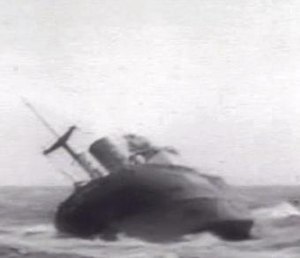SS Flying Enterprise

Still from newsreel footage of SS Flying Enterprise when she was sinking, 10 January 1952
|
|
| History | |
|---|---|
| Name: |
|
| Owner: |
|
| Port of registry: |
|
| Builder: | Consolidated Steel Corporation, Wilmington, California |
| Yard number: | 360 |
| Launched: | 7 January 1944 |
| Completed: | March 1944 |
| In service: | 18 March 1944 |
| Identification: | |
| Fate: | Sank 10 January 1952 |
| General characteristics | |
| Type: | Type C1-B ship |
| Tonnage: | 6,711 GRT |
| Length: | 396 ft 5 in (120.83 m), pp |
| Beam: | 60 ft 1 in (18.31 m) |
| Height: | 25 ft 8 in (7.82 m) |
| Propulsion: | 2 x Westinghouse Electric & Manufacturing Co steam turbines, double reduction geared driving one screw. 4,000 hp (3,000 kW) |
| Speed: | 14 knots (26 km/h) |
| Crew: | 48, plus 10 passengers |
SS Flying Enterprise was a 6,711 ton Type C1-B ship which sank in 1952. She was built in 1944 as SS Cape Kumukaki for the United States Maritime Commission for use in World War II. The ship was sold in 1947 and then operated in scheduled service under the name Flying Enterprise.
Cape Kumukaki was built by Consolidated Steel Corporation of Wilmington, California and launched on 7 January 1944. Delivered on 18 March 1944, she was owned by the United States War Shipping Administration and registered at Los Angeles.
After the end of World War II, she was sold in 1947 to the Isbrandtsen Company. At this time, her name was changed to the Flying Enterprise and re-registered in New York. For the next five years, she was used as a general cargo freighter in the North Atlantic.
On 21 December 1951, under the command of Henrik Kurt Carlsen, she left Hamburg, Germany bound for the USA. Among her cargo was 1,270 long tons (1,290 t) of pig iron and 486 long tons (494 t) of coffee, 447 long tons (454 t) rags, 39 long tons (40 t) peat moss, twelve Volkswagen cars, antiques and antique musical instruments, typewriters, 447 long tons (454 t) of naphthalene as well as ten passengers. There is speculation that the cargo also included gold and zirconium
Four days later, on Christmas night, she encountered a storm in the Western Approaches to the English Channel. Afterwards, it was discovered that she had suffered structural damage and a crack was found across the weather deck. The cargo then shifted. An SOS was issued on 28 December, by which time she was listing 45 degrees to port. British flagged vessel MV Sherborne and USS General A. W. Greely responded, Sherborne being first to arrive, early in the morning of 29 December. Carlsen, however, was reluctant to evacuate passengers and crew to a British ship. Sherborne was asked to remain on station in case the situation deteriorated before an American ship arrived. The situation did deteriorate, just as USS General A W Greely arrived mid-afternoon and both ships sent lifeboats to pick up passengers and crew. The crew and passengers were evacuated with the loss of one life (a male passenger). Captain Carlsen remained on board. After passengers and crew had been evacuated, MV Sherborne was released and continued her voyage to Manchester.
...
Wikipedia
